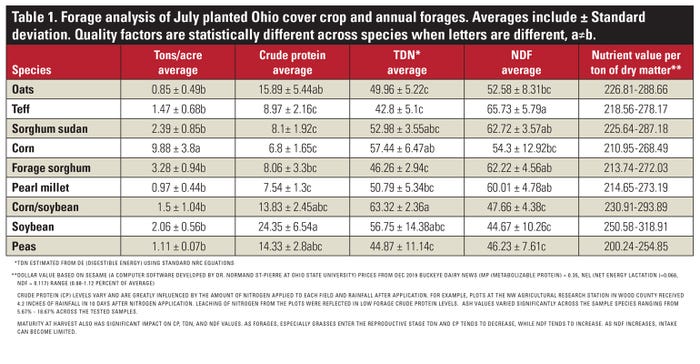March 19, 2020

The combination of poor-quality hay made in 2018, historic alfalfa winterkill and excessive rainfall across most of Ohio in spring 2019 created a large need for high-quality alternative forage sources this past year. Record amounts of prevented-plant acreage across the state created an opportunity to grow forages on traditionally row-cropped acres.
As crop and livestock producers planted a variety of forage and cover crop species to supplement feed stocks, it was recognized that there was also a need to gather forage analysis results from these fields for growers to properly value and feed the forage grown.
The following data are from cover crop forage samples submitted by farmers and from Ohio Agricultural Research and Development Center research stations, where annual forages were grown as part of the 2019 Ohio State University eFields program. The information is available at local Extension offices or at digitalag.osu.edu/efields.
Samples
A total of 208 forage samples were collected by farmers and county OSU Extension educators and sent to a lab for wet chemistry feed analysis. With the variety and mixes of species grown, wet chemistry analysis was chosen for increased accuracy of nutrient composition. Near infrared (NIR) analysis often costs less per sample and is best used when evaluating alfalfa or frequently grown monoculture grass hay. Full trial results by location and more quality factors, and samples with fewer than three locations can be found at go.osu.edu/forages19.
Results
The results shown in Table 1 show the differences in yield, crude protein (% CP); TDN (total digestible nutrients, a common quantifier of nutrient content); NDF (neutral detergent fiber, another common quantifier of nutrients); and forage value for species and mixes where there were multiple samples from at least three locations across the state.

Crude protein (CP) levels vary and are greatly influenced by the amount of nitrogen applied to each field and rainfall after application. For example, plots at the Northwest Agricultural Research Station in Wood County, Ohio, received 4.2 inches of rainfall in 10 days after nitrogen application. Leaching of nitrogen from the plots was reflected in low forage CP levels. Ash values varied significantly across the sample species, ranging from 5.67% to 18.67% across the tested samples.
Maturity at harvest also has significant impact on CP, TDN and NDF values. As forages, especially grasses, enter the reproductive stage, TDN and CP tend to decrease while NDF tends to increase. As NDF increases, intake can become limited.
Findings
When evaluating forages, knowing the nutritional requirement of the livestock you are feeding is key. Nutrition factors to consider are dry matter intake (DMI), % CP and TDN. On average, a lactating ewe requires the following: DMI, 4%; TDN, 64.52%; and CP, 14.84%. The needs of a 1,400-pound beef cow are vastly different, depending on stage of production. The following are requirements for maintenance: DMI, 1.7%; TDN, 50%; and CP, 7.1%. For lactation, requirements are DMI, 2.6%; TDN, 59%; and CP, 10.6%.
To supplement low-CP and -TDN and high-NDF forages, whole shelled corn, or corn gluten feed, may be a potential supplemental source of energy. Forages that are typically grown as winter annuals were found to either not grow, or have extremely low yields, when planted in the heat of summer: i.e., winter rye, winter wheat and winter barley.
Considering economics, corn silage planted in July yields the best dollar-per-acre value, because it’s significantly higher-yielding than other annual forages. After Aug. 1, one may consider planting oats to fill a forage need. As previous OSU research has shown, it is recommended that oats intended for forage be planted in early August to prevent seed production.
Ruff, Hartschuh and Gahler are OSU Extension educators for Agriculture and Natural Resources. They are also members of the OSU Extension Beef Team, which publishes the weekly Ohio BEEF Cattle letter. See the letter at beef.osu.edu.
You May Also Like




